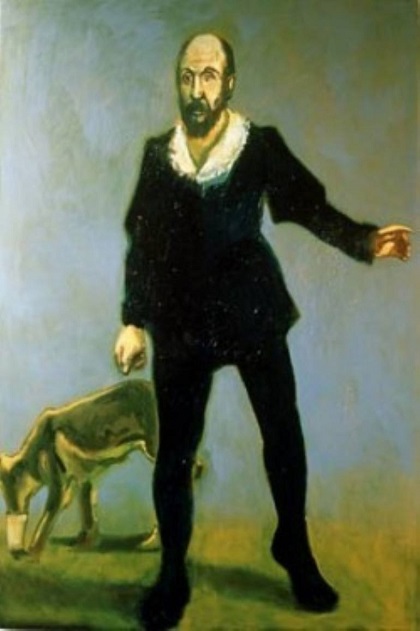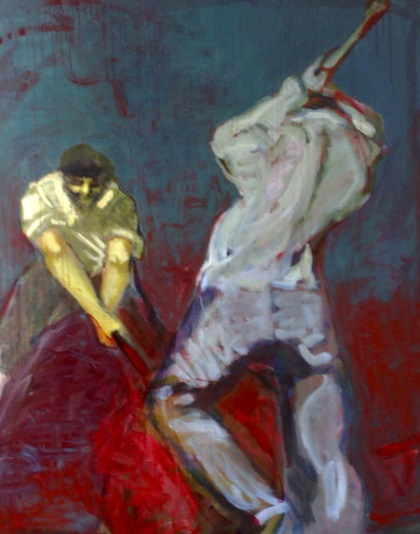Elpida Georgiou in the Department of English
Elpida Georgiou was Leverhulme artist in residence from 2007 to 2008 in the Department of English, working on a project that bridged art, literature and science, leading to the creation of a series of paintings based on Shakespearean characters and inspired by psychoanalysis.
Shakespeare dreams: death and desire
 In 2007 the Leverhulme Trust funded a year’s residency for Elpida to undertake a collaborative project with the Department of English at King's, where she worked closely with Professor Gordon McMullan, Professor of English, who specialises in Shakespeare and early modern drama. The aim of the residency was for Elpida to research the psychological dimensions of Shakespeare's plays and produce a series of large-scale oil paintings based on key psychological moments in the plays, seeking to offer challenging new perspectives on those moments.
In 2007 the Leverhulme Trust funded a year’s residency for Elpida to undertake a collaborative project with the Department of English at King's, where she worked closely with Professor Gordon McMullan, Professor of English, who specialises in Shakespeare and early modern drama. The aim of the residency was for Elpida to research the psychological dimensions of Shakespeare's plays and produce a series of large-scale oil paintings based on key psychological moments in the plays, seeking to offer challenging new perspectives on those moments.
Psychoanalysis has been indebted to Shakespeare from the beginning: Sigmund Freud was as dependent upon Shakespearean archetypes as he was on classical ones. Carl Jung similarly drew upon what he saw as the mythic power of the plays in his approach to the intersection of psychoanalysis and aesthetics. It is the conjunction of the Shakespearean text and psychoanalysis that inspired Elpida to create a series of paintings whilst in residency at King's. The works combined ancient, early modern and post-Freudian models of the mind as a way to address key Shakespearean concerns: melancholy, depression, madness, narcissism, jealousy, child-parent relationships and the roots of violence.
Image : Freud acting Hamlet, 2006-8, oil on canvas, Elpida Georgiou

Elpida’s residency spanned the visual arts, literature and science. Her aim was to reflect on the psychological models Shakespeare himself might have drawn upon and to seek a negotiation between those models and contemporary psychoanalytic perspectives. Shakespeare, for instance, drew on Galenic thinking in his engagement with ethics and moral psychology, and Elpida sought to incorporate this perspective in her work. In seeking to address Hamlet’s difficulties in forming and maintaining mature relationships, she incorporated awareness of, for instance, the properties of black bile as a metaphor for melancholy or yellow bile as a symbol of madness. Colour choices thus emerged from her negotiation of early modern understandings of the workings of the emotions.
Through her paintings, Elpida sought to interpret Shakespearean psychologies through a postmodern visual language of appropriation and allusion. The Jungian world of The Tempest, the narcissism of Othello, the Lacanian politics of Lear’s madness, such ideas were the starting points for a series of paintings which sought to move beyond approaches based on representation in order to probe Shakespeare’s dramatic achievement in his plays.
Image: Titus Andronicus, 2008, oil on canvas, Elpida Georgiou
Students from the Department of English visited Elpida in her studio during her residency to discuss the ideas Elpida was exploring in her work and to offer their own thoughts and suggestions. It gave them an opportunity to see how the literary works of Shakespeare could be interpreted in visual form.
The residency culminated in a ten-week exhibition (November 2008 - January 2009) of Elpida's Shakespearean paintings entitled Shakespeare dreams: death and desire. The subjects of the paintings included King Lear, Macbeth, Titus Andronicus, Hamlet, Julius Caesar, Othello, Twelfth Night and Richard III. The exhibition was held at the Institute of Psychiatry, Psychology & Neuroscience at King's and the opening included a seminar, organised by Professor McMullan, on the place of Shakespeare in the history of art.
About the artist
Elpida Georgiou is an artist living and working in London. She trained at Central Saint Martin’s between 1983 and 1986 and then at the Royal Academy, completing her MA in 1990. Elpida’s work first came to the attention of the art world when in 1990 she won the Guinness prize for a first-time exhibitor, following the Royal Academy Degree show.
Speaking about her work, Elpida has said 'I don’t like to talk about my paintings too much. That can become prescriptive and authoritarian. It is up to the viewer to create their own interpretations of what is before them.' She quickly established herself with her life-size figurative paintings and their trademark sculpted bodies, inspired by newspaper cuttings and war photography. Her paintings have been bought by renowned institutions and private collectors.